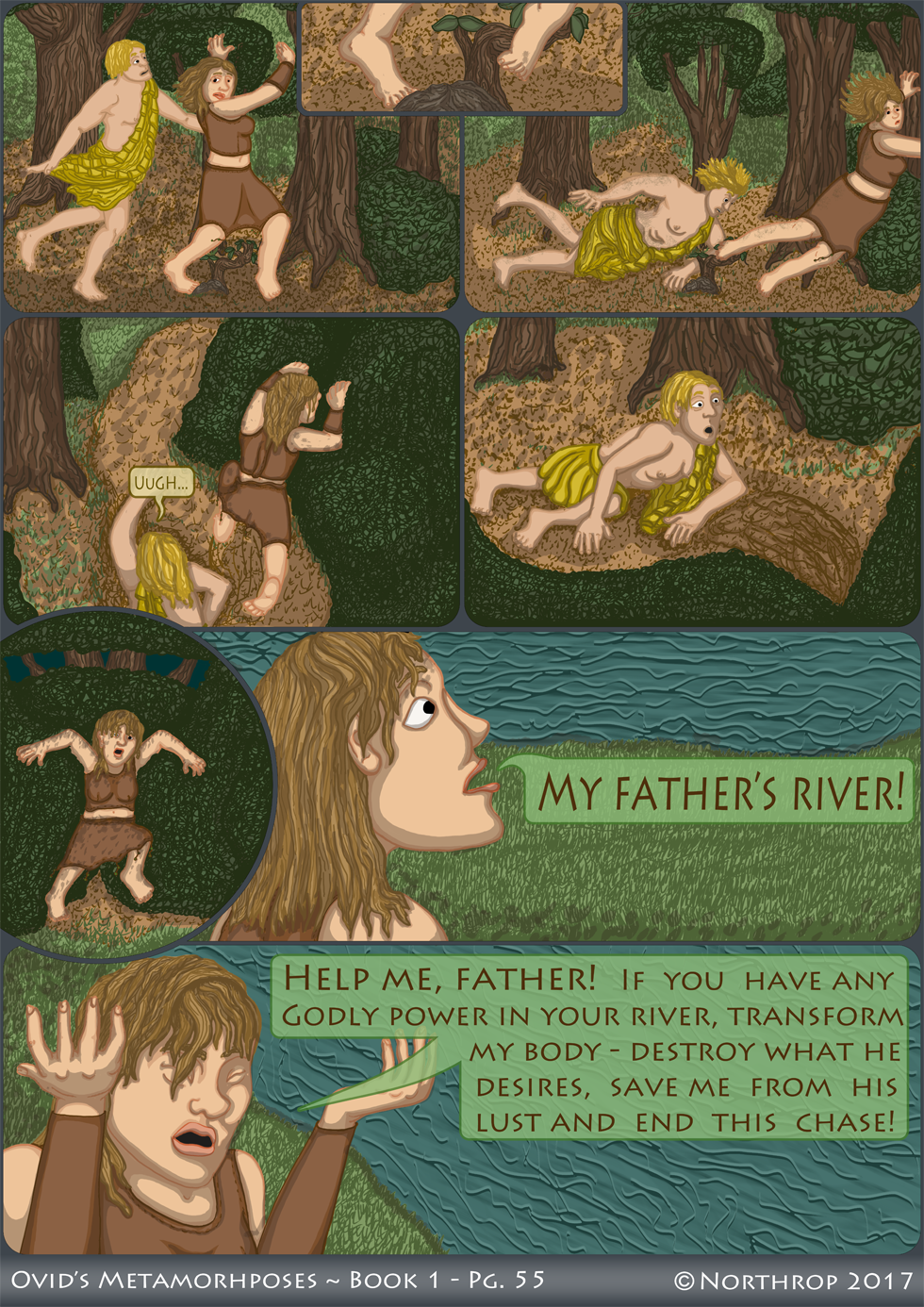Met. 1.540-7 – Daphne’s Prayer
qui tamen insequitur pennis adiutus Amoris
ocior est requiemque negat tergoque fugacis
imminet et crinem sparsum cervicibus adflat.
viribus adsumptis expalluit illa citaeque
[victa labore fugae “Tellus” ait, “hisce, vel istam, 544
quae facit ut laedar, mutando perde figuram.”] 545
victa labore fugae, spectans Peneidas undas, 544a
“fer, pater” inquit, “opem, si flumina numen habetis; 546
qua nimium placui, mutando perde figuram.”
(Met. 1.540-7)
Nevertheless, he chases her more quickly, aided by wings of Love,
and denies her rest. He hovers over the back of the fearful [girl],
and breathes on the hairs scattered over her neck.
Gathering all her strength, she goes pale and
[done in by the labour of her swift flight, says, “Earth, yawn open, or else
that which makes it so that I am hurt, my body, destroy it by changing it.”]
done in by the labour of her swift flight, says, “Help me, father, if you have any divinity in your waters;
use transformation to destroy my body, by which I have been too pleasing.”
I’m back with a new comic. Sorry again for the delay, but I was over in the UK, getting my PhD conferred on me by the University of Cambridge! Allow me to re-present myself as Dr Charlotte Gloria Nancy Northrop, MPhil PhD Cantab (lol) Right, okay, enough ego stroking; let’s get on to discussing this comic!
This is the moment where Daphne finally has enough. Her prayer focuses her suffering on one culprit: her body. It might seem an odd accusation, since we have seen that Cupid’s arrows are the real instigators of this whole chase (and beyond them, Apollo’s a strong candidate for being at fault). It would be tempting to say to that Ovid intends Daphne’s prayer to reveal her ignorance about the cause of Apollo’s lust, but this reading is undercut by Ovid’s apostrophe to Daphne about her beauty at Met. 1.488-9 (which I had Ovid literally saying to her on page 50). It’s one of a number of problematic interpretations of Apollo’s lust and Cupid’s arrows throughout this episode, which I will discuss at the very end of this episode in another post. For now, let us simply observe that, despite the faff about the arrows, Daphne’s desire to transform herself gets to the core of Ovid’s theme: changing bodies. In this episode, we see a strong connection between the body and the erotic (kinda obvious, but still…). This connection is born out of Ovid’s erotic past and will be important for understanding the sexual nature of much of the poem. So, Daphne may not have identified the divine cause of her predicament, but she is well attuned to the importance of the body and the power of transformation in the Ovidian poetic universe. We’ll see the results of her prayer shortly…
Now, before we go on with our lives and wait for the fabled “next update” of this comic, let’s talk about something very important. I want to talk about “Textual Criticism”… DON’T CLOSE THAT BROWSER WINDOW! I swear this is a fun topic… You see, it’s true that textual critics spend much of their time pouring over different versions of the same dusty text, looking for slight differences. That’s a bit boring… BUT! it’s part of their mission to determine whether a line is “original” or “interpolated”, that is, whether it was really written by the author or if a mischievious editor added or changed it somewhere down the line. This aspect of the job is fascinating, because it reveals how fragile texts really are, and how easy it is for major changes to be made over the course of time. The lines from today’s comic, which are copied from Tarrant’s OCT of the Metamorphoses, show just how difficult things can get for the textual critic when it comes time to publish a definitive text. You might have noticed the Latin up there goes 544, 545, 544a, 546. That’s wierd, but it has to do with the interpolated lines. See, there have been students tfor centuries reading that Daphne prayed to Tellus, goddess of the Earth (aka Gaia). It’s actually in keeping with the Daphne tradition, as far as we understand it. Parthenius, the only author before Ovid whose version of the Daphne story survives, does say she was transformed by Tellus. However, it is clear to textual critics (not just Tarrant) that Ovid had Daphne pray to her father, the river god Peneus (she has a different father in Parthenius). This is why her prayer invokes the waters of her father’s river, since this river is what gives him his divinity (in Greco-Roman mythology, river gods are seen as being both humanoid deities AND the actual river itself at the same time). The father doing the transformation brings us full circle back to beginning where Daphne asked him to remain a virgin forever. She makes two prayers to her father, and both are answered (sort of), making this version the more compelling one for the Metamorphoses. Combine with this an investigation into the history of editing the Metamorphoses, and you can be pretty sure that the Tellus prayer is the interpolated one. That’s why Tarrant puts the Tellus prayer in [brackets]; it’s not really an Ovidian line.
I know Thanksgiving is this week (it’s my first time celebrating it in the US in 10 years!!!!!), but I intend to work on the next page over the holiday, so stay tuned for Daphne’s transformation!

Discussion ¬